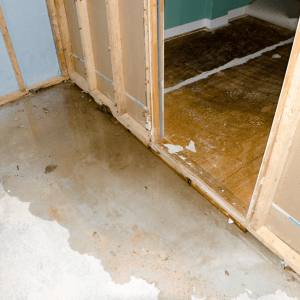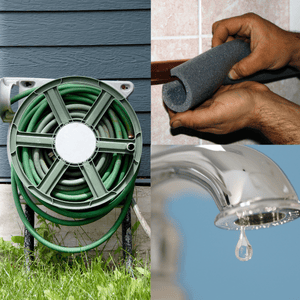When Texas freezes, chaos ensues. From icy roads to power outages, winter weather here is no small inconvenience. But perhaps the most dreaded surprise? Waking up to find water pouring from your ceiling or your floors submerged in an unplanned indoor pool.
Burst pipes are a common—and costly—consequence of freezing weather, especially in a state like Texas, where homes and plumbing systems aren’t typically built to withstand extreme cold. If you’re facing a burst pipe emergency or want to avoid one in the future, this guide will walk you through everything you need to know to act quickly and effectively.
At CK Restoration, we understand the stress and uncertainty a burst pipe can cause. That’s why we’ve outlined actionable steps to mitigate damage, address repairs, and prepare your home for the next freeze.
Why Do Pipes Burst During Freezes in Texas?
The science is straightforward: when water freezes, it expands. If the water inside your pipes freezes, the resulting pressure can cause them to crack or burst. What’s unique to Texas, however, is that many homes are designed with milder climates in mind, leaving plumbing systems more vulnerable to cold weather.
Key Causes of Burst Pipes:
- Uninsulated Pipes: Pipes located in unheated areas, such as attics, garages, or crawl spaces, are highly susceptible to freezing temperatures.
- Outdoor Faucets and Hoses: Without insulation or protection, these are often the first to freeze and burst during a cold snap.
- Aging or Poorly Maintained Plumbing: Older pipes made of materials like galvanized steel are more likely to fail under pressure.
- Improper Installation: Pipes located along exterior walls or without adequate insulation are particularly at risk.
Texas homes weren’t designed for sub-freezing temperatures, making preparation even more critical when winter storms strike.
Signs of Burst Pipes You Should Never Ignore
The sooner you recognize a problem, the better your chances of minimizing water damage. Some signs are subtle, while others are impossible to miss.
Subtle Clues:
- Low Water Pressure: A sudden or gradual drop in water pressure could mean there’s a blockage or a break in your plumbing.
- Unusual Noises: Banging, whistling, or gurgling sounds in your pipes may indicate trapped air or leaks.
- Damp Walls or Ceilings: Discoloration, bubbling paint, or unexplained wet spots could point to hidden leaks.
Obvious Signs:
- Water Pools Indoors: Large puddles or unexpected water flowing from walls or ceilings are clear indicators of a burst pipe.
- Visible Cracks or Frosted Pipes: If you see cracks in your pipes or frost on exposed plumbing, immediate action is necessary.
- Complete Loss of Water: No water flow at all could mean frozen pipes that have burst somewhere in the system.
Ignoring these signs can lead to extensive water damage, mold growth, and costly repairs.
First Things First: What To Do When a Pipe Bursts
When you discover a burst pipe, staying calm and taking swift action can make all the difference. Here’s your immediate game plan:
Step 1: Stop the Water
Locate your main water shut-off valve and turn it off immediately to prevent further flooding. Familiarize yourself with the valve’s location in advance so you’re not scrambling during an emergency.
Step 2: Shut Off Electricity
If water is leaking near electrical outlets, appliances, or wiring, turn off your home’s electricity at the breaker box to avoid electrical hazards.
Step 3: Protect Your Safety
Avoid standing water, especially if it’s near electrical sources. If the situation feels unsafe, evacuate the area and call a professional for help.
Temporary Fixes: Contain the Damage
After stopping the water flow, temporary fixes can help minimize damage until professional help arrives.
- Seal Small Cracks or Leaks: Use pipe clamps, rubber patches, or pipe repair tape to temporarily stop leaks.
- Redirect Water: Place buckets or containers under active leaks to catch dripping water and prevent further damage to floors.
- Dry the Area: Use towels, fans, or a dehumidifier to start drying wet areas and prevent mold growth.
While these measures can buy you time, they are not permanent solutions. Professional repairs are essential to fully resolve the issue and avoid future problems.
Call a Professional: When to Bring in the Experts
Some issues require immediate attention from trained professionals, especially if the damage is extensive or hidden.
When to Call CK Restoration:
- Persistent Leaks: If you can’t fully stop the flow of water, a plumber is necessary to repair the pipe.
- Structural Damage: Cracks in walls, sagging ceilings, or warped floors indicate severe water damage that requires professional remediation.
- Hidden Leaks: Professionals have specialized tools to detect leaks behind walls, under floors, or in hard-to-reach places.
CK Restoration specializes in emergency water damage solutions, offering everything from pipe repairs to complete water damage restoration.
Cleaning Up After a Burst Pipe: Addressing Water Damage

Once the immediate crisis is under control, it’s time to focus on cleanup and repair. Water damage can escalate quickly if left untreated, so don’t delay this step.
Steps for Cleanup:
- Remove Standing Water: Use wet vacuums, mops, or professional extraction equipment to remove water as quickly as possible.
- Dry Affected Areas: Set up fans and dehumidifiers to accelerate the drying process and prevent mold growth.
- Disinfect Surfaces: Clean all wet surfaces with disinfectants to kill bacteria and prevent mold.
- Check for Hidden Damage: Inspect behind walls, under floors, and in ceilings for water that may have seeped in.
For severe water damage, CK Restoration provides professional cleanup and repair services to restore your home to its pre-damage condition.
Can Burst Pipes Be Prevented? Winterizing Tips for Texan Homes

The best way to handle burst pipes is to prevent them from happening in the first place. With a few proactive steps, you can safeguard your home against freezing temperatures.
Winterizing Tips:
- Insulate Exposed Pipes: Use foam pipe insulation or heat tape on pipes in unheated areas.
- Keep Faucets Dripping: Letting water trickle through pipes helps relieve pressure and prevents freezing.
- Disconnect Outdoor Hoses: Drain and store hoses indoors, and cover outdoor faucets with insulated covers.
- Seal Drafts: Close gaps around windows, doors, and pipes that allow cold air to enter your home.
- Install Smart Water Sensors: Early detection of leaks can prevent small issues from becoming major disasters.
Taking these steps can significantly reduce the risk of burst pipes during future freezes.
Read more: Winter storms: Tips for preparing your house and pipes– TX Dept. of Insurance
Be Ready for the Next Freeze
Texas winters may be unpredictable, but your preparedness doesn’t have to be. By winterizing your home, knowing how to respond during a plumbing emergency, and working with trusted professionals like CK Restoration, you can minimize the stress and damage caused by burst pipes.
If you’re dealing with a burst pipe or want to winterize your home, CK Restoration is here to help. With 24/7 emergency services and expert repair solutions, we’ll get your home back to normal in no time.
Contact us today for immediate assistance or a consultation to protect your home this winter!

